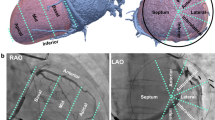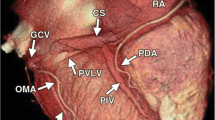Abstract
Purpose
This study was undertaken to evaluate the usefulness of electrocardiographically (ECG)-gated multidetector-row computed tomography (MDCT) for the assessment of the coronary venous system and detection of its anatomical variants, in order to identify those suitable for lead placement in cardiac resynchronisation therapy (CRT).
Materials and methods
We retrospectively examined the coronary MDCT studies of 89 patients (73 males, 16 females, average age 62.5 years, range 31–79) referred for suspected coronary artery disease. The cardiac venous system was assessed in all patients using three-dimensional (3D) postprocessing on a dedicated Vitrea workstation (five patients were excluded from the analysis).
Results
The coronary sinus, the great cardiac vein, the anterior interventricular vein and the middle cardiac vein were visualised in all cases. The lateral cardiac vein was visualised in 56/84 patients (67%) and the posterior cardiac vein in 63/84 patients (75%), never both missing. Along the postero-lateral wall of the left ventricle, only one branch was present in 44 cases, two branches in 21 cases and three or more branches in 19/84 cases (22%). Evaluation of the maximum diameter revealed that the lateral vein was dominant over the posterior vein in 20/40 cases. The small cardiac vein was visualised in 11/84 cases.
Conclusions
MDCT provides good depiction of the cardiac venous system, enabling the study of the vessel course and the identification of anatomical variants. Hence, this imaging technique could be proposed for the preoperative planning of CRT in selected patients.
Riassunto
Obiettivo
Scopo del nostro lavoro è valutare l’utilità della tomografia computerizzata multistrato (TCMS) nell’individuazione delle varianti anatomiche del sistema venoso coronarico al fine di riconoscere quelle ritenute più idonee per l’impianto dell’elettrocatetere necessario per la terapia di resincronizzazione cardiaca (CRT).
Materiali e metodi
Sono stati valutati retrospettivamente 89 pazienti consecutivi (73 maschi e 16 femmine, età media 62,5 anni, range di età 31–79), sottoposti ad angio—TCMS per sospetta patologia coronarica. Abbiamo valutato il sistema venoso coronarico in tutti i pazienti utilizzando una workstation dedicata Vitrea per il postprocessing 3D (5 pazienti sono stati esclusi).
Risultati
Il seno coronarico, la grande vena cardiaca, la vena interventricolare anteriore e la vena cardiaca media sono state visualizzate in tutti i pazienti. La vena cardiaca laterale è stata visualizzata in 56/84 casi (67%), mentre la vena cardiaca posteriore in 63/84 casi (75%); in nessun caso mancavano entrambe. Complessivamente in prossimità della parete postero-laterale del ventricolo sinistro è stato possibile visualizzare un solo ramo in 44 casi, due rami in 21 casi, tre o più rami in 19 casi. Nei pazienti che presentavano due rami per la parete posterolaterale del ventricolo sinistro, valutando il calibro massimo della vena, la vena laterale è stata considerata dominante sulla posteriore in 20/40 casi. La piccola vena cardiaca è risultata visualizzabile in 11/84 casi.
Conclusioni
La TCMS permette una buona visualizzazione delle vene coronariche, consentendo lo studio del decorso vasale e l’identificazione delle varianti anatomiche. Pertanto, questa tecnica di imaging potrebbe essere proposta nel planning dei pazienti da sottoporre alla CRT.
Similar content being viewed by others
References/Bibliografia
Cademartiri F, Runza G, Belgrano M (2005) Introduction to coronary imaging with 64-slice computed tomography. Radiol Med 110:16–41
Pannu HK, Flohr TG, Corl FM (2003) Current concepts in multidetector row CT evaluation of the coronary arteries: principles, techniques, and anatomy. Radiographics 23:S111–S125
Schoepf UJ, Zwerner PL, Savino G (2007) Coronary CT angiography. Radiology 244:48–63
Halon DA, Rubinshtein R, Gaspar T (2008) Current status and clinical applications of cardiac multidetector computed tomography. Cardiology 109:73–84
Woodard PK, Bhalla S, Javidan-Nejad C et al (2006) Non-coronary cardiac CT imaging. Semin Ultrasound CT MR 27:56–75
Hendel RC, Patel MR, Kramer CM et al (2006) ACCF/ACR/SCCT/SCMR/ASNC/NAS CI/SCAI/SIR 2006 Appropriateness criteria for cardiac computed tomography and cardiac magnetic resonance imaging: a Report of the American College of Cardiology Foundation Quality Strategic Directions Committee Appropriateness Criteria Working Group, American College of Radiology, Society of Cardiovascular Computed Tomography, Society for Cardiovascular Magnetic Resonance, American Society of Nuclear Cardiology, North American Society for Cardiac Imaging, Society for Cardiovascular Angiography and Interventions, and Society of Interventional Radiology. J Am Coll Cardiol 48:1475–1497
Benini K, Marini M, Del Greco M et al (2008) Role of multidetector computed tomography in the anatomical definition of the left atrium-pulmonary vein complex in patients with atrial fibrillation. Personal experience and pictorial assay. Radiol Med 113:779–798
Cademartiri F, Runza G, Luccichenti G et al (2006) Coronary artery anomalies: incidence, pathophysiology, clinical relevance and role of diagnostic imaging. Radiol Med 111:376–391
Abraham WT, Fisher WG, Smith AL et al (2002) Cardiac resynchronization in chronic heart failure. N Engl J Med 346:1845–1853
Abraham WT, Hayes DL (2003) Cardiac resynchronization therapy for heart failure. Circulation 108:2596–2603
Gasparini G (2005) La stimolazione atrio-ventricolare e biventricolare nello scompenso cardiaco. It J Practice Cardiol 2:55–60
Ghio S, Constantin C, Klersy C et al (2004) Interventricular and intraventricular dyssynchrony are common in heart failure patients, regardless of QRS duration. Eur Heart J 25:571–578
Cazeau S, Leclercq C, Lavergne T et al (2001) Effects of multisite biventricular pacing with heart failure and intraventricular conduction delay. N Engl J Med 344:873–880
Bristow MR, Saxon LA, Boehmer J et al (2004) Cardiac resynchronization therapy with or without an implantable defibrillator in advanced chronic heart failure. N Engl J Med 350:2140–2150
Pensa A, Favaro G, Cattaneo L (1996) Trattato di anatomia umana. Edizione UTET, Torino
Singh JP, Houser S, Heist EK et al (2005) The coronary venous anatomy: a segmental approach to aid cardiac resynchronization therapy. J Am Coll Cardiol 46:68–74
Cademartiri F, Marano R, Luccichenti G et al. (2004) Normal anatomy of the vessels of the heart with 16-row multislice Computed Tomography. Radiol Med 107:11–23
Hewitt MJ, Chen JTT, Ravin CE et al (1981) Coronary Sinus atrial pacing: radiographic considerations. AJR Am J Roentgenol 136:323–328
Vardas PE, Auricchio A, Blanc JJ et al (2007) Guidelines for cardiac pacing and cardiac resynchronization therapy. The Task Force for Cardiac Pacing and Cardiac Resynchronization Therapy of the European Society of Cardiology. Developed in collaboration with the European Heart Rhythm Association. Europace 9:959–998
Tada H, Kurosaki K, Naito S et al (2005) Three-dimensional visualization of the coronary venous system using multidetector row computed tomography. Circ J 69:165–170
Abbara S, Cury RC, Nieman K et al (2005) Noninvasive evaluation of cardiac veins with 16-MDCT angiography. AJR Am J Roentgenol 185:1001–1006
Christiaens L, Ardilouze P, Ragot S et al (2008) Prospective evaluation of the anatomy of the coronary venous system using multidetector row computed tomography. Int J Cardiol 126:204–208
Jongbloed MRM, Dirksen MS, Bax JJ et al (2005) Atrial fibrillation: multi-detector row CT of pulmonary vein anatomy prior to radiofrequency catheter ablation. Initial experience. Radiology 234:702–709
Mühlenbruch G, Koos R, Wildberger JE et al (2005) Imaging of the cardiac venous system: comparison of MDCT and conventional angiography. AJR Am J Roentgenol 185:1252–1257
Van de Veire NR, Schuijf JD, De Sutter J et al (2006) Non-invasive visualization of the cardiac venous system in coronary artery disease patients using 64-slice computed tomography. J Am Coll Cardiol 48:1832–1838
Lemola K, Mueller G, Desjardins B et al (2005) Topographic analysis of the coronary sinus and major cardiac veins by computed tomography. Heart Rhythm 2:694–699
Van de Veire NR, Marsan NA, Schuijf JD et al (2008) Noninvasive imaging of cardiac venous anatomy with 64-slice multi-slice computed tomography and noninvasive assessment of left ventricular dyssynchrony by 3-dimensional tissue synchronization imaging in patients with heart failure scheduled for cardiac resynchronization therapy. Am J Cardiol 101:1023–1029
Knackstedt C, Mühlenbruch G, Mischke K et al (2008) Imaging of the coronary venous system: validation of three-dimensional rotational venous angiography against dual-source computed tomography. Cardiovasc Intervent Radiol 31:1150–1158
Morin RL, Gerber TC, McCollough CH (2003) Radiation dose in computed tomography of the heart. Circulation 107:917–922
Picano E (2004) Informed consent and communication of risk from radiological and nuclear medicine examinations: how to escape from a communication inferno. BMJ 329:849–851
Einstein AJ, Henzlova MJ, Rajagopalan S (2007) Estimating risk of cancer associated with radiation exposure from 64-slice computed tomography coronary angiography. JAMA 298:317–323
Bluemke DA, Achenbach S, Budoff M et al (2008) Noninvasive coronary artery imaging: magnetic resonance angiography and multidetector computed tomography angiography: a scientific statement from the American Heart Association Committee on Cardiovascular Imaging and Intervention of the Council on Cardiovascular Radiology and Intervention, and the Councils on Clinical Cardiology and Cardiovascular Disease in the Young. Circulation 118:586–606
Author information
Authors and Affiliations
Corresponding author
Rights and permissions
About this article
Cite this article
Lumia, D., Laganà, D., Canì, A. et al. MDCT evaluation of the cardiac venous system. Radiol med 114, 837–851 (2009). https://doi.org/10.1007/s11547-009-0417-3
Received:
Accepted:
Published:
Issue Date:
DOI: https://doi.org/10.1007/s11547-009-0417-3




